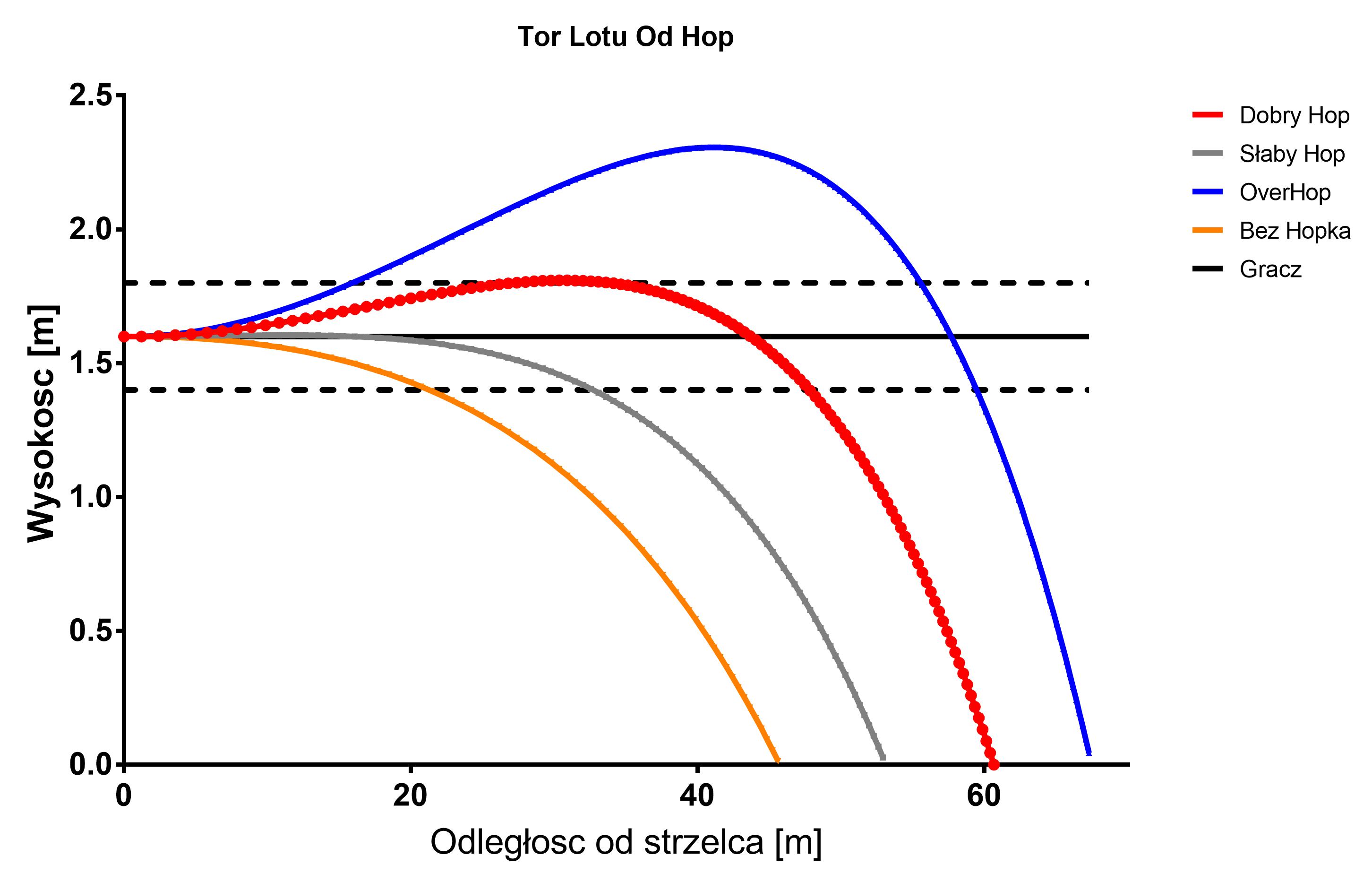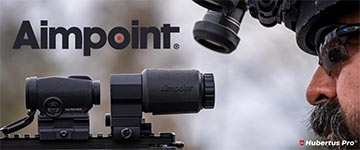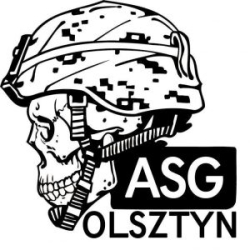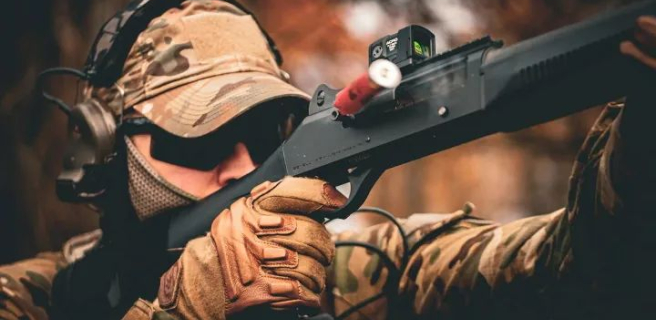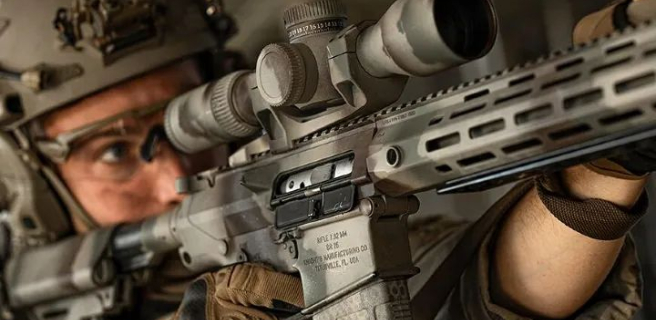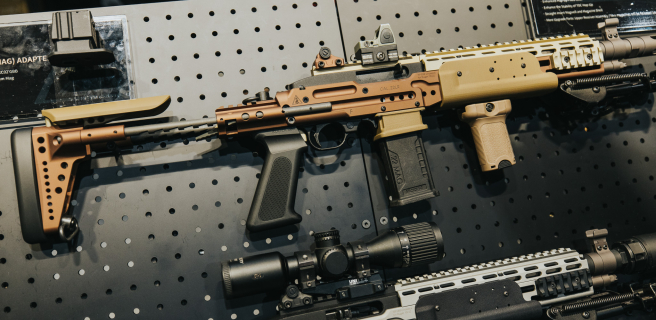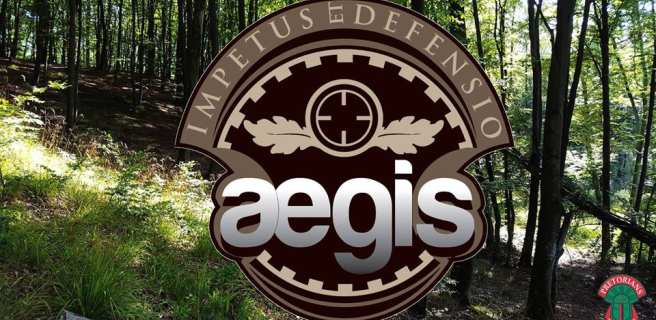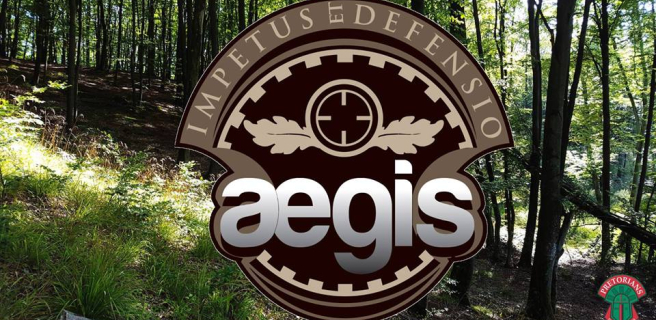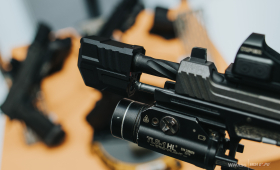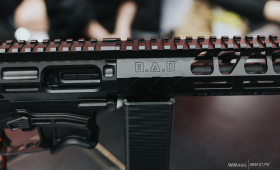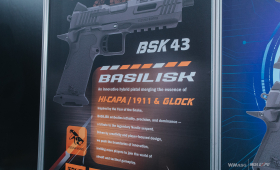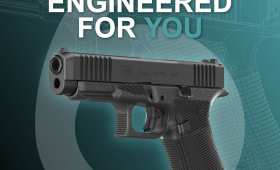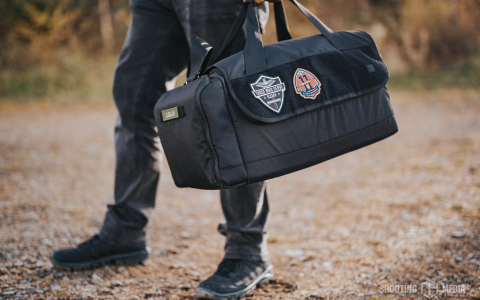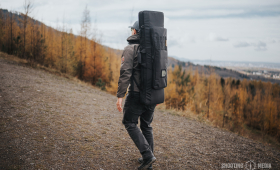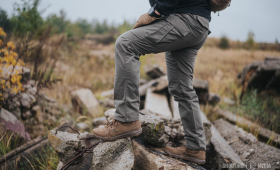ATTENTION! Discussion at the WMASG forum about the topic raised in this article can be found here: https://wmasg.com/pl/forum/topic/168088-fizyka-a-tor-lotu-kulki/
Introduction
The following article will present information obtained from a script I wrote myself, which simulates the physics of a trajectory of an airsoft BB. The purpose of this script was to examine relations between various factors, i.e. the relation of the range to the mass of a BB propelled with the same energy. Or the relation between the range to the muzzle velocity. This script, however, is not ideal. First of all, it can not be used to calculate the exact ranges as these also depend on conditions that are specific at a given game area such as humidity or temperature. Consequently, in order to obtain the data that interested me, I had to base my calculation on some average values. Having that said, I achieved a relatively high similarity between the results of my calculations and the knowledge I gained through my own experience.
I will also say in advance that this article will not bear any shocking discoveries as it was not its purpose. This text is about confirmation, through physics, of various truths that have been functioning in our community for a long time.
Simulation criteria
A few words about the criteria of the simulation:
- Unless stated otherwise, each shot is taken parallel to the ground, on flat terrain without wind.
- I assume that a well set Hop-up is one where a BB will rise to a height of 1.8 meters (which is more or less the height of a human).
- I count the range as the point at which the BB reaches the ground level.
- If it is not written otherwise, then the graphs were made for a power of 1.9 J (corresponding to 450 FPS using 0.2 g BBs) and 0.25 g BBs.
- FPS, or rather energy, is already calculated after the hop-up is set.
- I assume the rifle or rather a shot is perfect. In other words, when leaving the barrel, the BB has the speed vector ideally correlating with the direction of the barrel.
BB trajectory and the Hop-Up
The first question that arose is, of course, how does a BB trajectory looks like? Usually, with a well set Hop-Up (in the diagram below it is the red color), a BB slowly rises, so that after reaching its maximum range, it will drop to the ground much faster. As you can easily see, until the BB drops too much, it will hit more or less (plus or minus 20 cm) where we aimed it. Above a certain range (here, around 50 meters), the BB drops much faster. If we aim at an opponent standing on a road (that is, a piece of terrain without any branches), we will hit him/her regardless. Usually, however, the situation is much more problematic. There are twigs, and you can see, for example, only a piece of an opponents jacket. And then players must make appropriate corrections. The more experienced a player is and well acquainted with his/her replica, the sooner the corrections will be made (personally, to make this kind of corrections a scope in an airsoft replica becomes really useful).
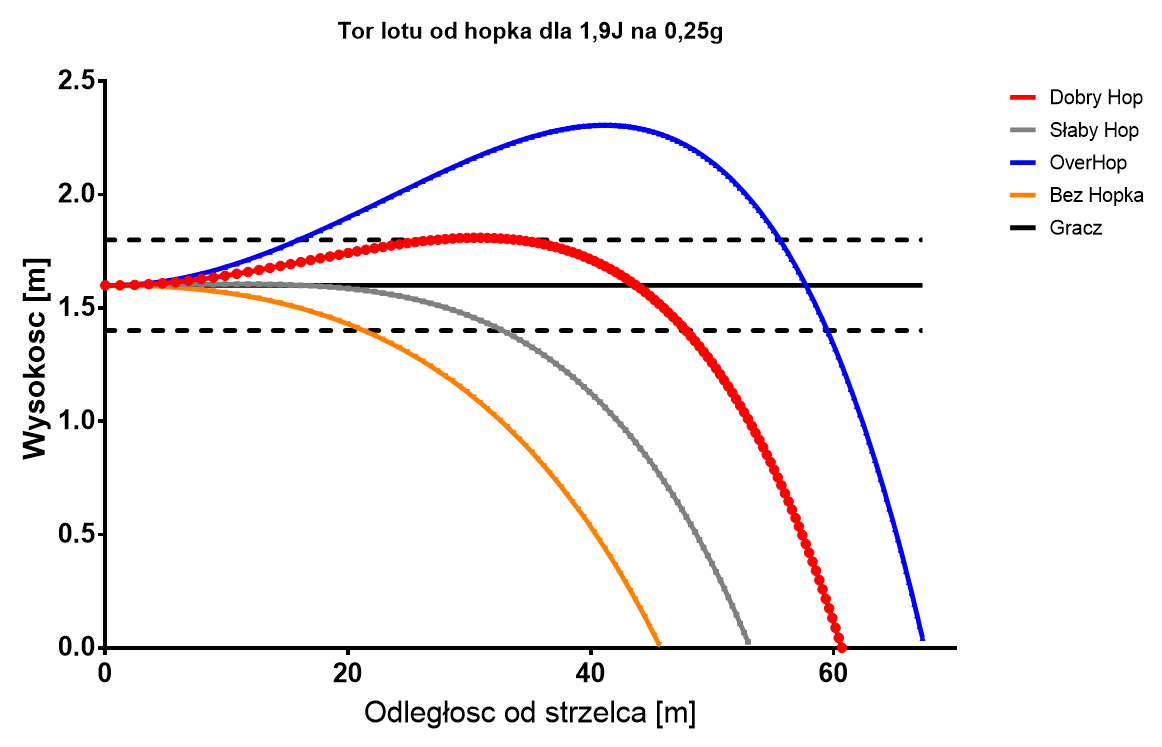
Trajectory on different Hop-Up settings for 1.9 J and 0.25 g BBs: height [m], distance from the shooter [m], RED - well set Hop-Up, GREY - too weak Hop-Up, BLUE - too strong Hop-Up, ORANGE - no Hop-Up, BLACK - player's average height.
In the diagram I also presented three hypothetical situations - too weak Hop-Up, too strong Hop-Up and no Hop-Up. Too weak Hop-Up does not require any comments - if we set the Hop-Up in a wrong way, then we lose range and BBs drop faster. If we make the Hop-Up too strong, then we have a so-called "over-hop", a situation where the BBs, after traveling a certain distance, fly over a target. In the case shown in the diagram, when aiming straight at an opponent, between 20 and 50 meters, we will shoot over over his/her head. Contrary to what it seams, this is not a rare phenomenon and players make this mistake very often. On the other hand, with an "over-hop", you can hit targets further away. Overshooting targets situated between 20 and 50 meters can be compensated by shooting below them. It is doable, but again, aiming is much more difficult.
And finally, it is interesting to compare the shot with the Hop-Up set properly to one without a proper setting. As you can see, Hop-Up is responsible for increasing the range by almost 1/4 (from 46 to 60 meters). What's more, if we look at the distance of the effective range, the gain is even greater. Thanks to the Hop-Up we gain roughly 3/5 of this distance (from 20 to 48 meters). And that's why a well-functioning Hop-Up is the basic thing in every decent replica. While preforming any kind of tuning, it's worth to start from the Hop-Up and then deal with the power or accuracy of the replica.
And since we got to the power ....
Range in relation to FPS and BB mass
One of the most common questions when it comes to tuning is - "What do I do to increase the range?". And in the minds of many airsoft players range = the amount of FPS.
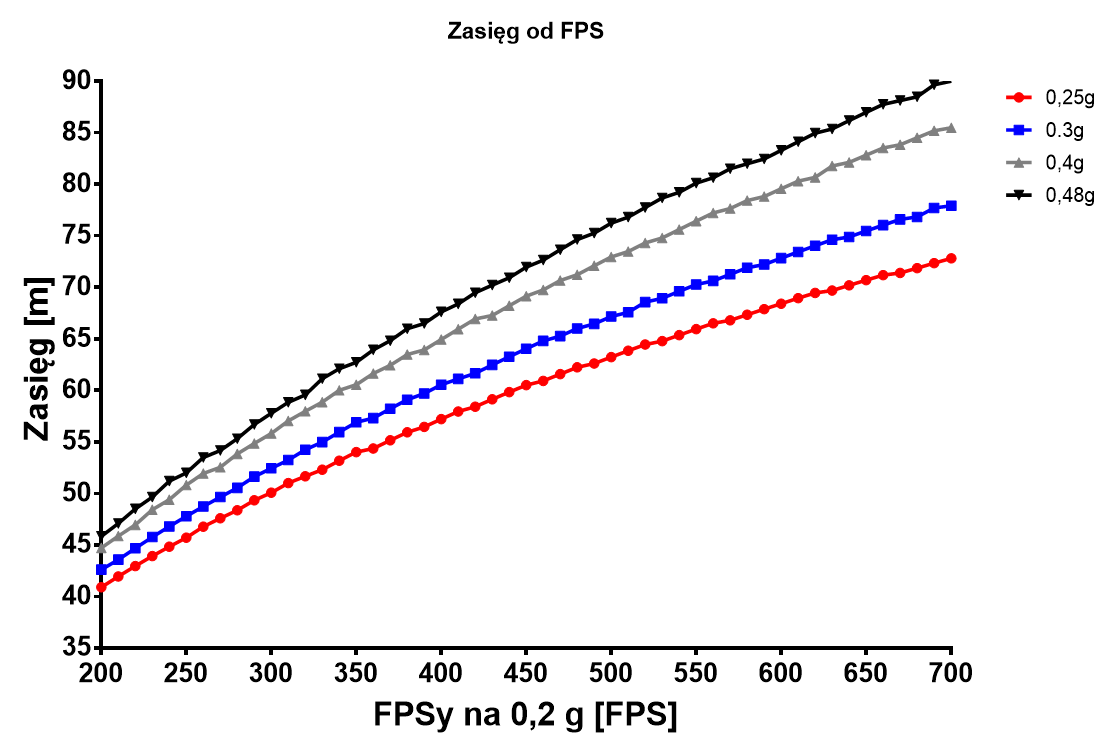
Range in relation to FPS: range [m], FPS using 0.2 g BBs.
At the beginning I would like to add that when I mention FPS here, what I mean are FPS using 0.2 g BBs. Also, I treat it as a measurement of the energy of a BB. I am aware of the existence of the "Joule Creep" and my calculations are made using Joules, but during presentation of the results, it is better to show FPS because there are more players who understand how much 450 FPS is rather than those who understand how much 1.88 J is.
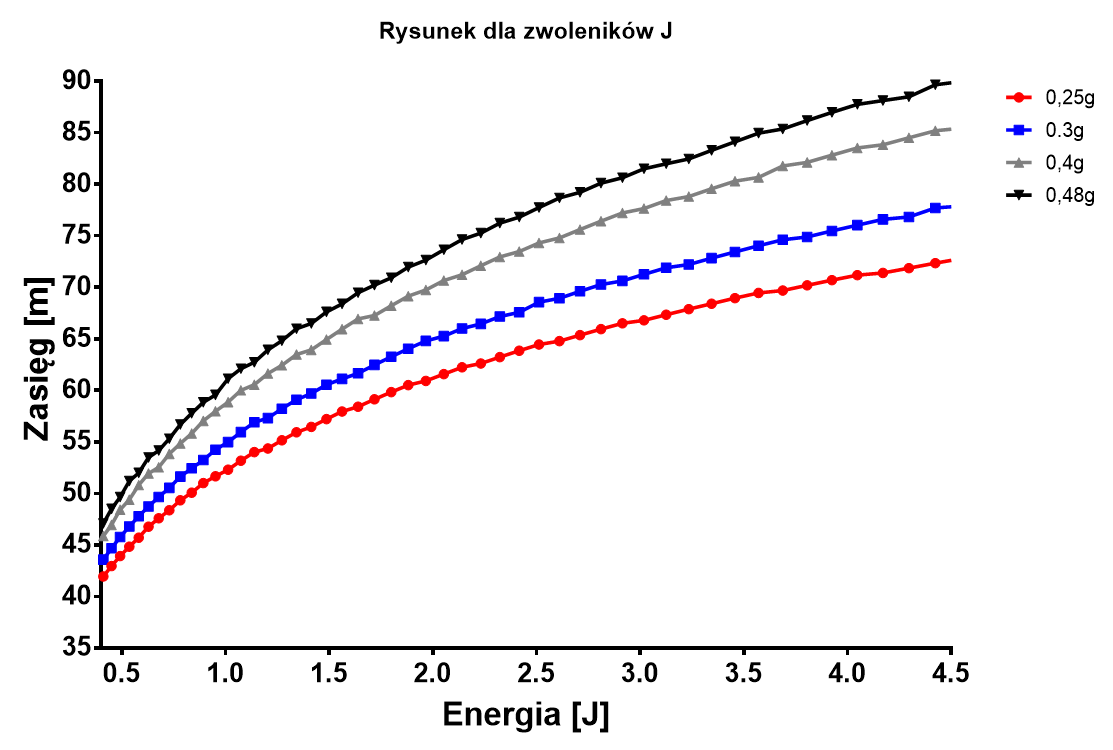
Diagram for Joules advocates: range [m], energy [J].
Coming back to the question whether range equals FPS. This is true to some extent. The more FPS we have, the more range we get out of our rifle. Also, the more FPS we have the faster the BBs will reach their target. On the other hand, there are a few limitations we have to be mindful of. First of all, the range does not only depend on the amount of FPS. It is affected by several other factors, such as the mass of a BB, or whether the Hop-Up can handle it. Secondly, what is the purpose of having greater range, when BBs fly in all directions? Sometimes it is better to invest in an upgrade that gives you more precision, because then, although the maximum range will not change, the effective range will, significantly. Thirdly, it is absolutely not true that by increasing FPS by 10% (or energy by 21%), we will get a 10% increase in range. It does not work this way. We will have an increase, yes, but of just 5-6% (the exact values depend on the amount of FPS and a BB's mass). In practice, to increase the range by 1 meter, the power must be increased by 15-16 FPS. To be more precise, we refer to such amounts of FPS that make sense for a given mass of a BB. No sensible person will shoot using 0.25 g BBs at 600 FPS.
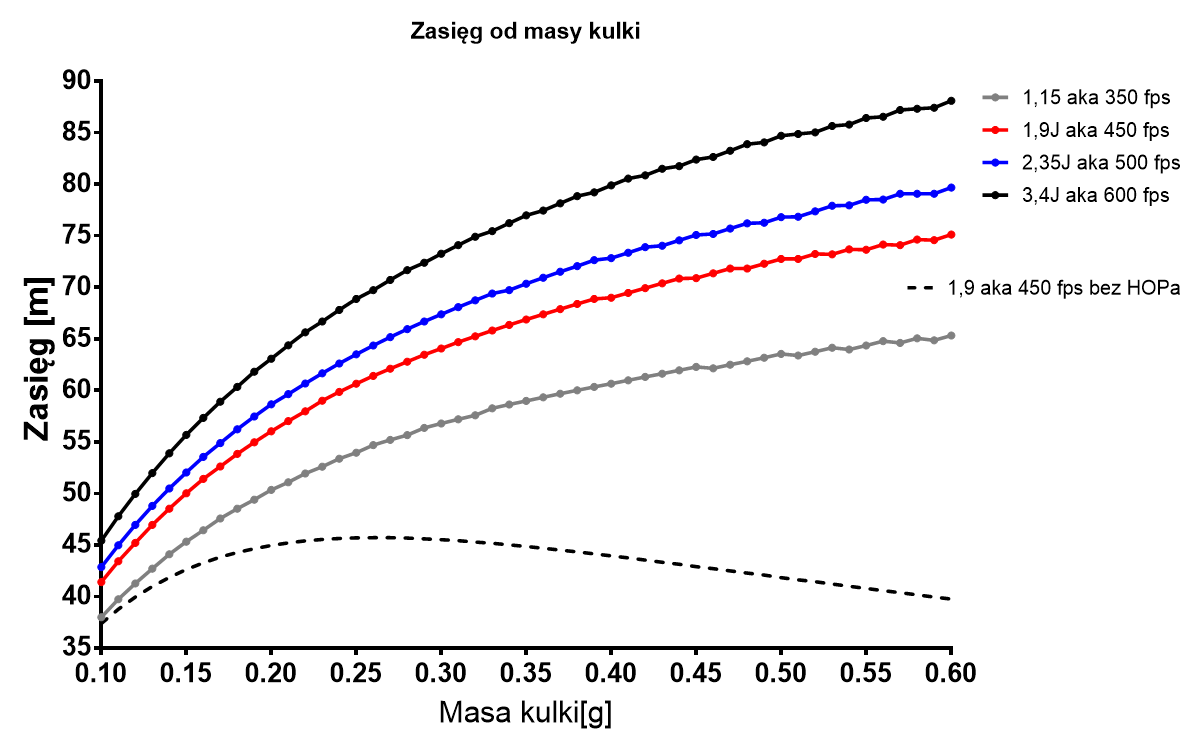
Range in relation the the mass of a BB: range [m], mass of a BB [g].
Apart from the FPS, the type of BBs used is a very important factor in regards to range. For a very long time, the belief that "heavier BBs are more accurate, but lighter BBs have greater range" has persisted in our community (such information is even found in the old guides published on WMASG). The supposed logic behind this theory was that heavier BBs are less susceptible to wind (which is true - heavier BBs are more accurate), and lighter have a higher muzzle velocity. The myth that lighter BBs travel further is still very widespread. Last month I have heard this statement in several different places and made by airsoft veterans. The problem is that heavier BBs do cover a greater distance.
Why do heavier BBs are able to do that? The problem here is the air resistance, which depends on the square of the speed and the second principle of Newton's dynamics, which in turn says that the speed change is inversely proportional to the mass. In other words, forces will act on the BBs in such a way as to quickly equalize their speed, and then a greater mass will have a complete advantage. As a curiosity, I would add that if there was no air resistance, our replicas would have 2-3 times more range.
Whats more important, the increase in range in relation to the increase of mass is greater for lighter BBs. Slowly, together with the increase of mass, a "saturation" syndrome occurs. In other words, for a certain mass of BBs, there will be no further increase in range, and it may even decrease. But for replicas with a Hop-Up this applies to masses far beyond our area of interest (the BBs would have to be made from uranium).
In practice, to obtain an increase of 1 meter in the range, the BB's mass must be increased by 0.012 g to 0.025 g. Compared to the FPS, change of BBs from 0.25 g to 0.3
g on a muzzle velocity of 450 FPS corresponds to an increase of about 60 FPS. And this is not taking into account the improvement of accuracy and hence the improvement of the effective range.
Of course, one can ask: if heavier BBs are more accurate and have greater range, why bother buying lighter BBs? For three reasons.
First of all, for economic reasons. It's not enough that, usually, 1 kilogram of heavier BBs is more expensive but there are fewer BBs per kg. If someone shoots a few thousand BBs per game (e.g. players with LMG replicas) then quite considerable amounts of money have to be spend on ammunition alone. If the writer this text used 0.3 g BBs during ordinary games, then during one year he would spend the amount of money corresponding to a price of a medium price range replica.
Secondly, because heavier BBs are, after all, slower. Not much, but noticeably so. I attached a diagram showing the dependence of the time a BBs reaches the end of its range in relation to its mass. Remember, in airsoft you can sometimes do the proverbial "bullet time", especially if someone is using, for example, 0.3 g BBs in a 300 FPS replica.
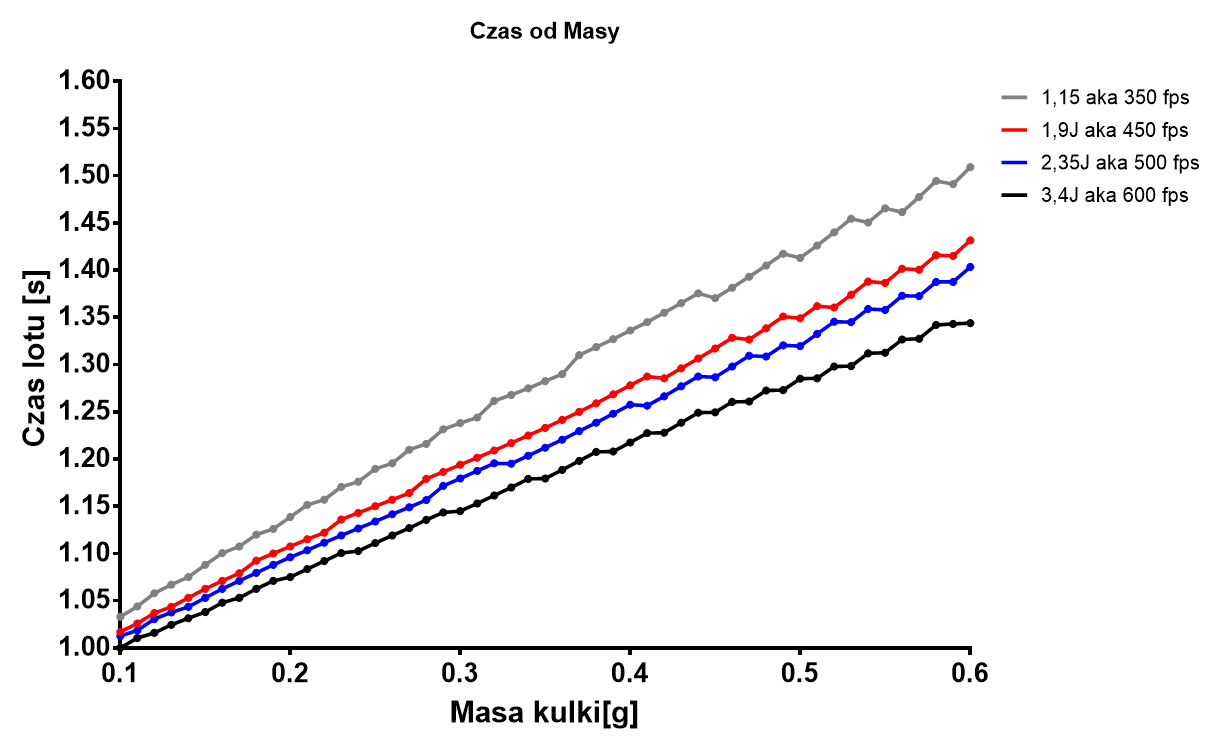
Time in relation to mass: travel time [s], BB mass [g].
And thirdly, because the Hop-Up will not always manage to work on heavier BBs. And why would it not?
Hop-Up in relation to FPS and BB mass
Hop-Up is associated with the Magnus effect, that is, the generation of force directed perpendicularly to the movement due to the body's rotation. This lifting force depends on the speed at which the BB travels and how fast it rotates. If it rotates too fast, the BB will quickly rise above the player's silhouette. In other words, the Hop-Up setting has to be done precisely, so that our replica gives the BB the right angular speed. For practical reasons, in my calculations, instead of angular velocity, I used something that I completely incorrectly called the "spin", which is a value directly proportional to the angular velocity.
From the basics of physics, we know that the larger the mass of a BB (assuming that their size is the same), the larger the inertia, which in turn will mean that in order to get it to the same level of spin/angular velocity it must be pressed harder by the Hop-Up. On the other hand, the quicker we propel a BB (aka we give it a greater FPS value), the bigger spin we should enact on it.
Having said that, the exact dependence of the angular velocity in relation to the BB and FPS used on the same Hop-Up setting depends on a given replica. Different types of Hop-Ups as well as different buckings will generate significant differences here.
What can be examined, however, is the level of spin that is needed to give a BB a proper trajectory depending on its mass and FPS applied.
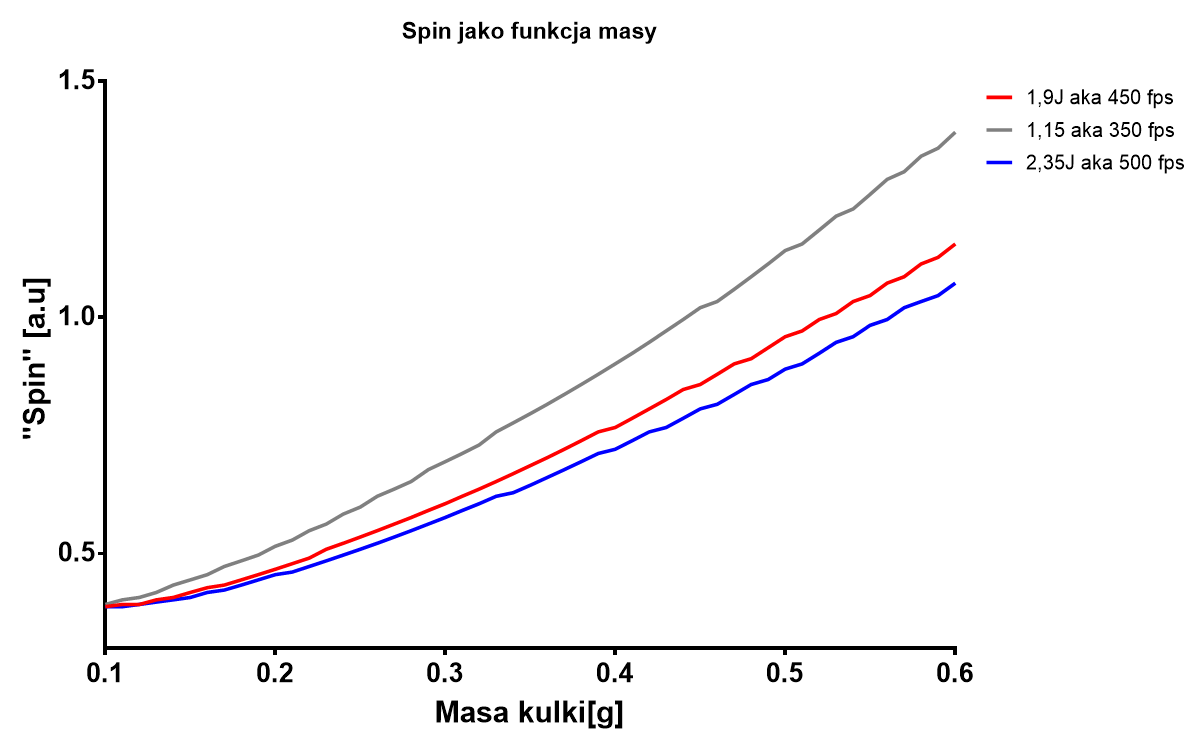
Spin as a function of mass: "Spin" [a.u]. BB mass [g].
Clearly, if you want to use heavier BBs, you need to get a higher angular velocity for a BB. In other words, exercise more pressure with the Hop-Up. As you can guess, it is not always possible. Sometimes the spacer is fully extended or the BB jams inside the chamber. In such cases, using a heavier BB will decrease the maximum and effective range.
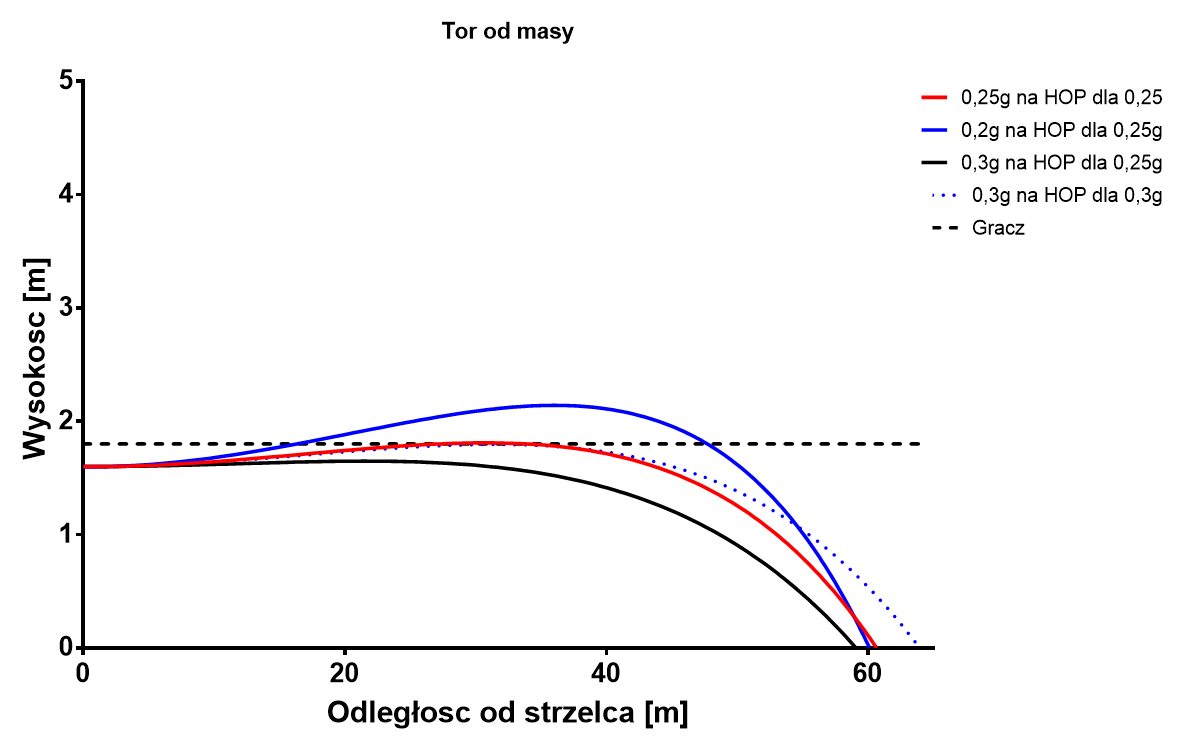
Trajectory in relation to mass: height [m], distance from the shooter [m], RED - 0.25 g BBs on Hop-up set for 0.25 g BBs, BLUE - 0.2 g BBs on Hop-up set for 0.25 g BBs, BLACK - 0.3g BBs on Hop-up set for 0.25 g BBs, BLUE DOTS - 0.3 g BBs on Hop-up set for 0.3 g BBs, BLACK LINES - player's average height.
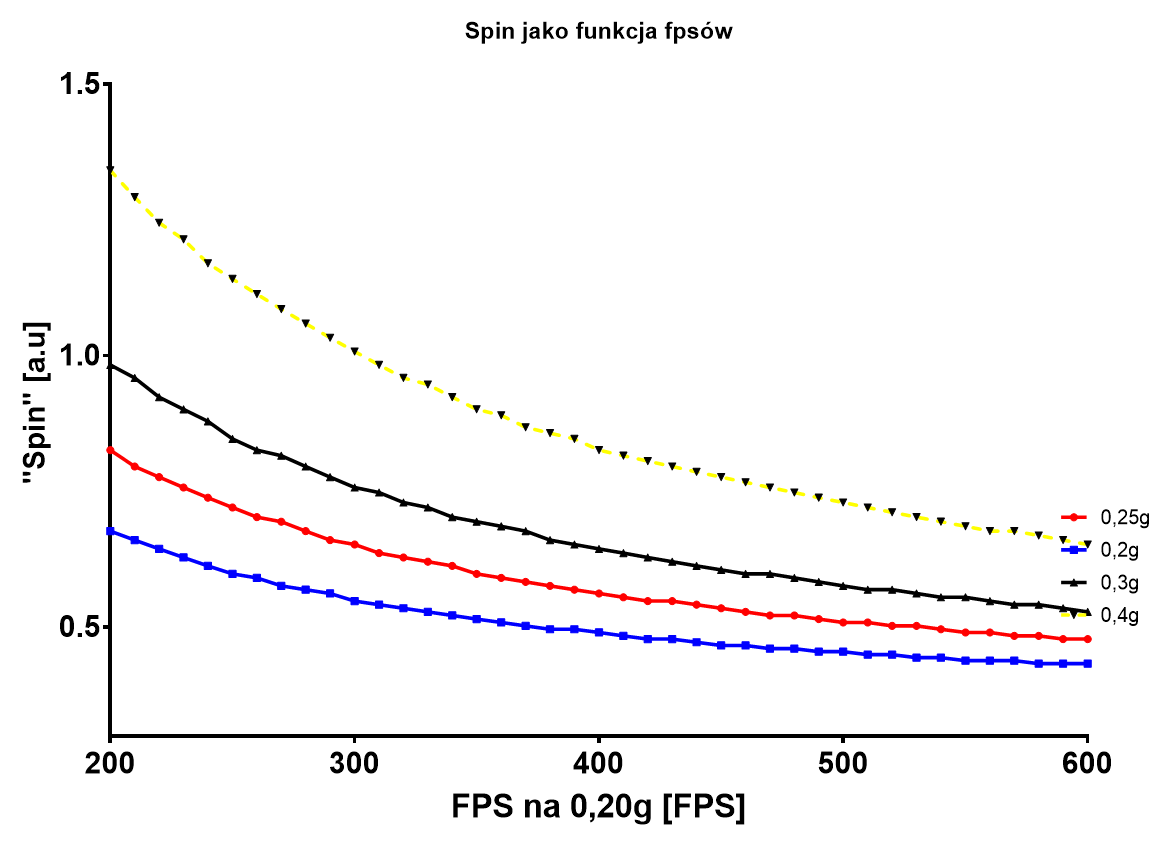
Spin as a function of FPS: "Spin" [a.u]. FPS using 0.2 g BBS [FPS].
In turn, increasing the muzzle velocity causes the required spin value to decrease. In other words, if we replace the spring in our replica with a stronger one then, in theory, we should loosen the Hop-Up a bit.
Exactly what BBs can be use at what FPS values depends on a particular replica. All tables describing that at "such" FPS one should be using "such" BBs are not worth much when faced with the diversity of replicas available. It is suffice to say that there are known cases of using 0.45 g in replicas below 350 FPS (or 1.15 J).
In other words, if someone wants to choose the right weight of BBs, it is best to test different weights and match them to the style he/she plays airsfot games.
Shooting at over 100 meters, that is using a ballistic curve
I am pretty sure that someone viewing this article, after seeing the diagrams regarding range, will say: "Wait a minute! And what about shots at ranges over 100 meters ?! These also occur." There is no denying that such achievements happen in our hobby. However, this is associated with shooting at an upward angle, using a phenomenon known as the ballistic curve. If we shoot at a higher angle, the range can effectively increase. The disadvantage of such shooting is twofold. First of all, the BB is in the air for a significant period of time, much longer than when shot parallel to the ground. This, of course, this means that the influence of potential wind is much greater. Also, any imperfections of a given replica (or BBs) will be evident here. The second problem is related to the first, namely, targeting is not trivial. If you make too large of a correction, it is very easy to overshoot a target. If the correction is too small the BBs will not reach it.
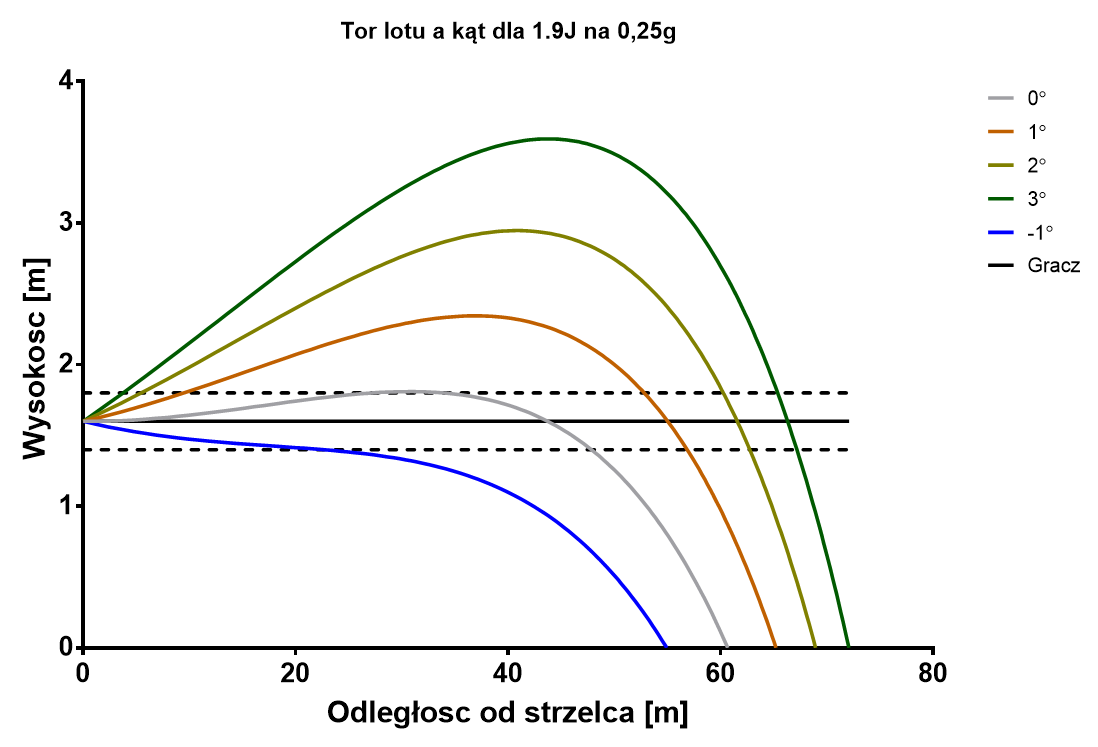
Trajectory in relation to the firing angle for 1.9 J using 0.25 g BBs: height [m], distance from the shooter [m]. BLACK LINES - player.
I carried out a simulation showing on what distances one can shoot at in relation to the angle the barrel is at. Although shooting in real airsoft game conditions at an angles of 30 degrees and more is not very common (tree branches and BB travel time), it is worth to read this diagram.
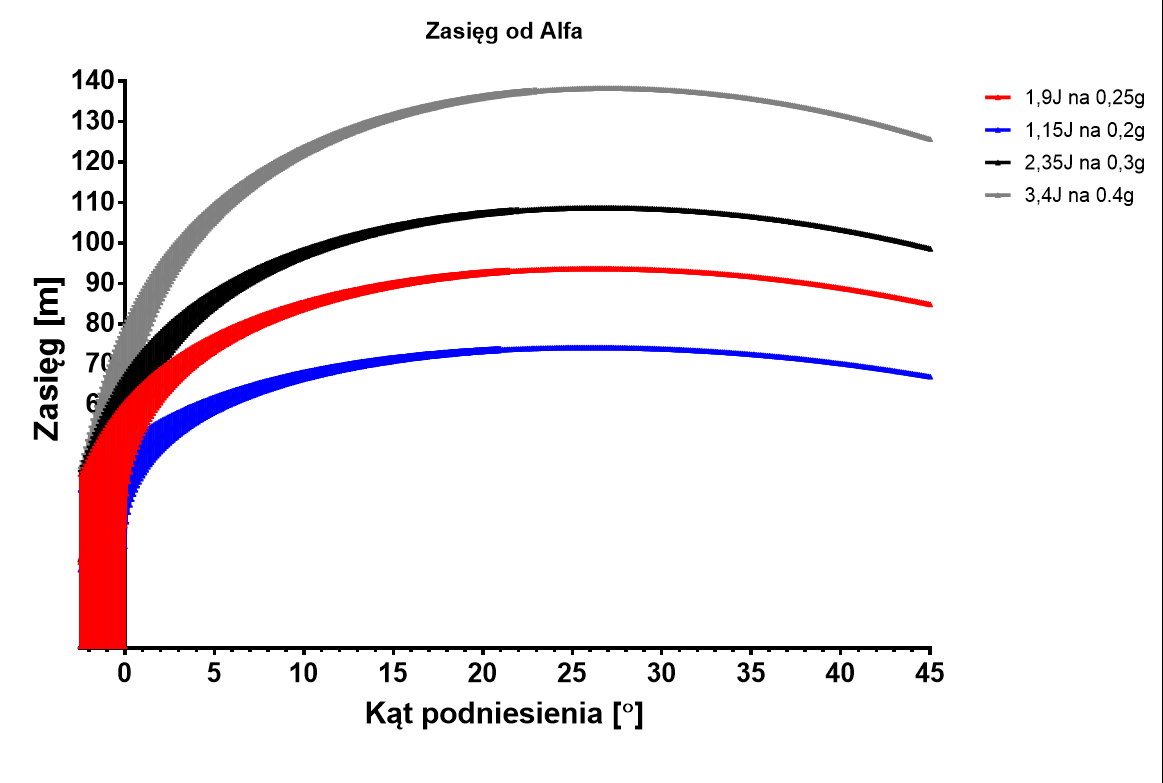
Range from Alpha: range [m], barrel angle [°], RED - 1.9 J on 0.25 g BBs, BLUE - 1.15 J on 0.2 g BBs, BLACK - 2.35 J on 0.3 g BBs, GREY- 3.4 J on 0.4 g BBs.
The diagram should be read in the following way: we choose the distance at which we want to shoot, e.g. 100 meters. next we draw a horizontal line and on its basis we can determine what barrel angle you needed to reach those 100 meters (without an excess).
And so, a sniper rifle replica having a muzzle velocity of 600 FPS and loaded with a 0.4 g BB, must raise its aiming line by 2.7-4 degrees to reach 100 meters. DMR replicas with 0.3g BBs, from 11 to 13 degrees. If its is risen, for example, by 15 degrees, in those conditions the shots will miss. Well, unless there is wind or shooters will not stand on an equal ground level or ...
There are a lot of these "or" factors. In practice, shooting using a ballistic curve is an art that not everyone can master, even if you skip the requirement that the rifle must be more accurate than in the case of a "normal" range. In particular, most of us do not have a precise protractor in our eyes. For this reason, the amount of the correction is usually given (i.e. how many meters above the target did the shooter aim).
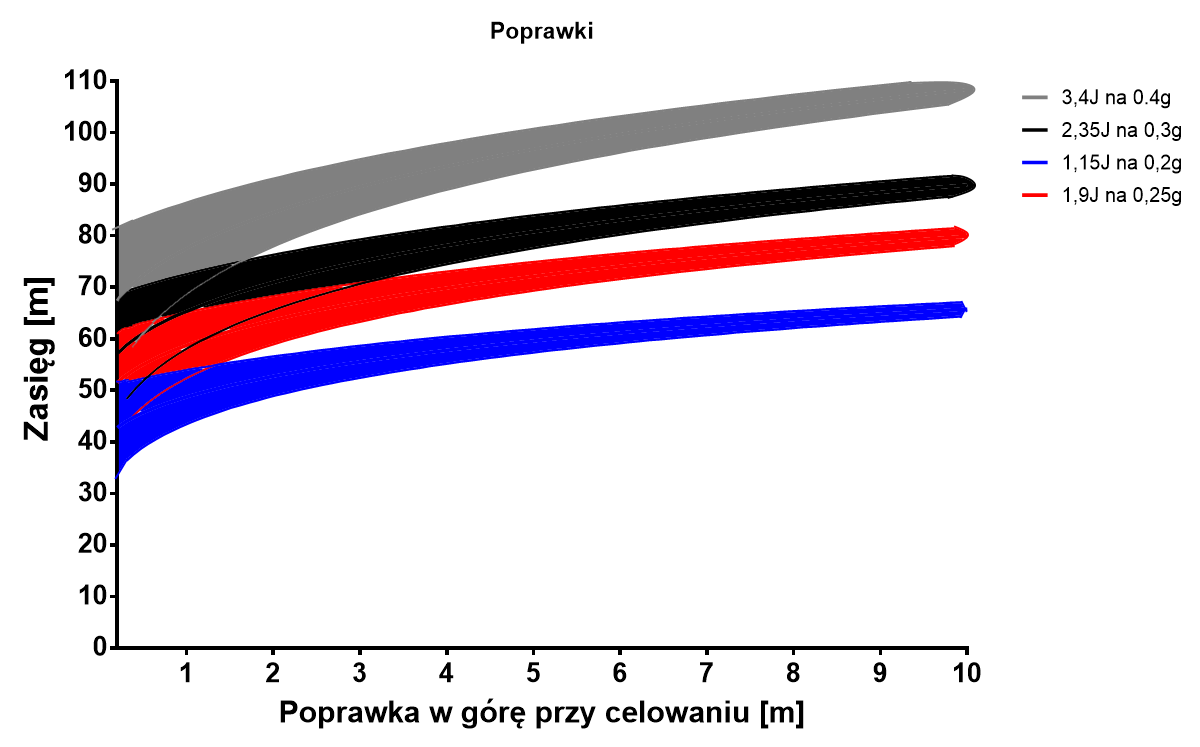
Corrections: range [m], correction above the targets [m], GREY- 3.4 J on 0.4 g BBs, BLACK - 2.35 J on 0.3 g BBs, BLUE - 1.15 J on 0.2 g BBs, RED - 1.9 J on 0.25 g BBs.
Both the distance from the shooter and the height are relatively easy to estimate, and hence, it is possible to used this in airsoft.
Summary
As I wrote at the beginning, the purpose of this article was not to discover something new. In practice, all the things described here are well known to most active players. But, as I will say again, it was not the goal. The purpose of this text was to collect and "confirm" as many "truths" as possible, known to airsoft players, so that there would be a place where the more inquisitive of the new players will be able to find them. And what are these truths?
- A well set Hop-Up is responsible for 25% of maximum and 50% of effective range;
- Too weak Hop-Up setting reduces the range, and too strong setting results in overshooting the target;
- The weight of a BB corresponds to the range as much as FPS do;
- Heavier BBs are more accurate and have a greater range;
- The heavier the BB, the greater the Hop-Up pressure must be;
- The more the FPSs the weaker the Hop-Up pressure must be
- When shooting upwards, you can increase the range, but you will have to have a lot of experience, skill and a good replica to do it in a repetitive manner.

